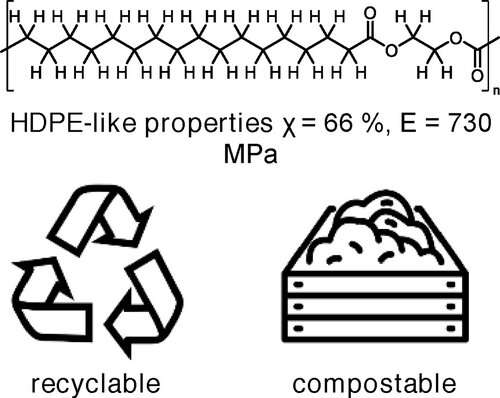This article has been reviewed according to Science X's editorial process and policies. Editors have highlighted the following attributes while ensuring the content's credibility:
fact-checked
peer-reviewed publication
trusted source
proofread
Researchers develop new biodegradable plastic with thermoplastic properties similar to polyethylene

Polyethylene has a number of advantageous properties, but biodegradability is not one of them. A team of researchers has now developed a plastic which has similar thermoplastic properties to polyethylene but is also biodegradable. The material in question is a semicrystalline polyester that breaks down fully to its starting materials using mild chemical or biological processes, as the team explain in their study published in the journal Angewandte Chemie International Edition.
High-density polyethylene (HDPE) is a particularly strong and durable material. It owes its thermoplastic properties to the internal structure of its molecular chains, which are arranged in a crystalline manner with added attraction due to van der Waals forces. The molecular chains are also pure hydrocarbons. The combination of crystallinity and hydrocarbon content means microorganisms, which might be able to degrade the plastic, cannot access the chains to break them up.
The research group of Stefan Mecking and colleagues, at the University of Konstanz, Germany, have now developed a polyester that has similar crystallinity to HDPE and also retains its beneficial mechanical properties. Unlike polyethylene, polyesters also contain functional groups that could theoretically be degraded chemically or enzymatically. However, under normal circumstances, the more crystalline a polyester is (i.e., the more similar to HDPE), the less readily it can be biodegraded.
The team was therefore understandably surprised by how quickly their crystalline polyester degraded when exposed to enzymes. "We tested degradation with naturally occurring enzymes, and it was an order of magnitude faster than with our reference material," Mecking explains. It wasn't just enzymatic solutions which degraded the material: soil microorganisms were also able to completely compost the polyester.
But what is it that makes this polyester so exceptionally biodegradable? The team were able to identify the significant contribution of ethylene glycol, one of the building blocks of the polyester. Mecking adds: "This building block is actually really common in polyesters. It gives you a high melting point, but it also increases degradability in these polyethylene-like materials."
Because of its good chemical and biological degradability, together with its mechanical properties, the new polyester could find applications as a recyclable thermoplastic material with minimal environmental impact. The end goal is closed-loop chemical recycling to break the plastic down into its raw materials and produce new plastics, Mecking adds. The added benefit of the team's plastic is that, if any materials do get into the environment despite this closed loop, they can biodegrade and leave no lasting impact.
More information: Marcel Eck et al, Biodegradable High‐Density Polyethylene‐like Material, Angewandte Chemie International Edition (2022). DOI: 10.1002/anie.202213438
Journal information: Angewandte Chemie International Edition
Provided by Wiley




















